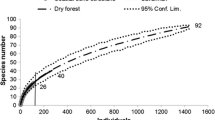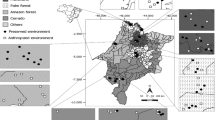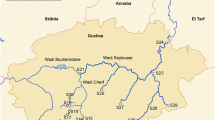Abstract
Islands act as natural laboratories for ecological studies to explain bioinvasion processes and, in this scenario, necrophagous Diptera have never been used as model organisms. This study aimed to (i) describe assemblages of necrophagous Diptera (Calliphoridae and Sarcophagidae) in two insular environments of different origins and distances from mainland, (ii) investigate the effect of anthropogenic impact on the assemblage of carrion flies, (iii) to quantify the establishment of invasive species in the two islands, and (iv) to infer about the conservation status of the islands based on the ecological parameters. Sampling was performed in 2011–2012, in the dry and rainy season. Insects were collected by using traps with chicken liver or sardine baits. In each island, environments exposed to different degrees of human impact were sampled. Ecological analyses were carried out to characterize the assemblages of Calliphoridae and Sarcophagidae, with emphasis on the relation between native and invasive species. In total, 99,862 adults of 21 species of blow flies and flesh flies were collected. Overall abundance in the oceanic island was higher than in the continental island, although the richness of species was higher in the latter. The type of bait did not influence diversity of species sampled in either island. No difference was observed in total richness of both families according to the gradient of anthropogenic impact, in both islands. The invasive species Chrysomya megacephala (Fabricius) was classified as dominant in all environments, irrespective of the anthropogenic impact, which raises concern about the conservation status of each island.




Similar content being viewed by others
References
Aguiar-Coelho VM, Milward-de-Azevedo EMV (1995) Associação entre larvas de Chrysomya megacephala (Fabricius) e Chrysomya albiceps (Wiedemann), Chrysomya megacephala (Fabricius) e Cochliomyia macellaria (Fabricius) (Calliphoridae, Diptera) sob condições de laboratório. Rev Bras Zool 12:991–1000
Baumgartner D, Greenberg B (1985) Distribution and medical ecology of the blow flies (Diptera: Calliphoridae) of Peru. Ann Entomol Soc Am 78:565–587
Brasil (2012). Relatórios Dinâmicos – Indicadores Municipais. Available from: www.portalodm.com.br/relatorios/PDF/gera_PDF.php?cidade=33420 Accessed 3 Mar 2013
Byrd JM, Castner JL (2010) Forensic entomology: the utility of arthropods in legal investigations. CRC, London, p 705
Cabrini I, Grella MD, Andrade CFS, Thyssen PJ (2013) Richness and composition of Calliphoridae in an Atlantic Forest fragment: implication for the use of dipteran species as bioindicators. Biodivers Conserv 22:2635–2643
Cardoso P, Arnedo MA, Triantis KA, Borges PAV (2010) Drivers of diversity in Macaronesian spiders and the role of species extinctions. J Biogeogr 37:1094–1046
Carmo RFR, Vasconcelos SD (2014) First record of the blow fly Chrysomya megacephala (Diptera: Calliphoridae) on a southern Atlantic island: implications for disease transmission in a protected environment. J Vector Ecol 39:228–230
Carvalho LML, Mello-Patiu CA (2008) Key to the adults of the most common forensic species of Diptera in South America. Rev Bras Entomol 52:390–406
Carvalho CJB, Ribeiro PB (2000) Chave de identificação das espécies de Calliphoridae (Diptera) do Sul do Brasil. Rev Bras Parasitol V 9:169–173
Carvalho CJB, Casari AS, Constantino R (2012) Insetos do Brasil: Diversidade e Taxonomia. Fapeam/Holos, Ribeirão Preto 810
Couri MS, Barros GP, Orsini MP (2008) Dipterofauna do Arquipélago de Fernando de Noronha (Pernambuco, Brasil). Rev Bras Entomol 52:588–590
Cowie RH, Holland BS (2006) Dispersal is fundamental to biogeography and the evolution of biodiversity on oceanic islands. J Biogeogr 33:193–198
D’Almeida JM (1984) Sinantropia de Sarcophagidae (Diptera) na região metropolitana do Rio de Janeiro. Arquivos UFRRJ 7:101–110
D’Almeida JM, Almeida JR (1998) Nichos tróficos em dípteros caliptrados, no Rio de Janeiro, RJ. Rev Bras Biol 58:563–570
Debinski DM, Holt RD (2000) A survey and overview of habitat fragmentation experiments. Conserv Biol 14:342–355
Denno RF, Cothran WR (1976) Competitive interactions and ecological strategies of sarcophagid and calliphorid flies inhabiting rabbit carrion. Ann Entomol Soc Am 69:109–113
Early M, Goff ML (1986) Arthropod succession patterns in exposed carrion on the island of O’ahu, Hawaiian Islands, USA. J Med Entomol 23:520–531
Faria LDB, Godoy WAC (2001) Prey choice by facultative predator larvae of Chrysomya albiceps (Diptera: Calliphoridae). Mem Inst Oswaldo Cruz 96:875–878
Freitas GCC, Vasconcelos SD (2008) Scorpion fauna of the island of Fernando de Noronha, Brazil: first record of Tityus stigmurus (Arachnida: Buthidae). Biota Neotrop 8:235–237
Gabre RM, Adham FK, Chi H (2005) Life table of Chrysomya megacephala (Fabricius) (Diptera: Calliphoridae). Acta Oecol 27:179–183
Gadelha BQ, Ferraz ACP, Aguiar-Coelho VM (2009) A importância dos mesembrinelíneos (Diptera: Calliphoridae) e seu potencial como indicadores de preservação ambiental. Oecol Bras 13:661–665
Gillespie RG, Claridge EM, Roderick GK (2008) Biodiversity dynamics in isolated island communities: interaction between natural and human-mediated processes. Mol Ecol 17:45–57
Goodbrod JR, Goff ML (1990) Effects of larval population density on rates of development and interactions between two species of Chrysomya (Diptera: Calliphoridae) in laboratory culture. J Med Entomol 27:338–343
Guimarães JH, Prado AP, Linhares AX (1978) Tree newly introduced blowfly species in southern Brazil (Diptera, Calliphoridae). Rev Bras Entomol 22:53–60
Heleno RH, Ceia RS, Ramos JA, Memmott J (2009) Effects of alien plants on insect abundance and biomass: a food-web approach. Conserv Biol 23:410–419
IBGE. Instituto Brasileiro de Geografia e Estatística. Ilha de Itamaracá (2013). Available from http://cidades.ibge.gov.br/xtras/perfil.php?lang=andcodmun=260760andsearch=pernambuco|ilha-de-itamaraca Accessed 25 Apr 2014
Kenis M, Auger-Rozenberg M, Roques A, Timms L, Péré C, Cock MJW, Settle J, Augustin S, Lopez-Vaamonde C (2009) Ecological effects of invasive alien insects. Biol Invasions 11:21–45
Kosmann C, Mello RP, Harterreinten-Souza ES, Pujol-Luz JR (2013) A list of current valid blow fly names (Diptera: Calliphoridae) in the Americas South of Mexico with key to the Brazilian species. Entomol Brasilis 6:74–85
Linhares AX (1981) Synanthropy of Calliphoridae and Sarcophagidae (Diptera) in the city of Campinas. São Paulo, Brazil Rev Bras Entomol 25:189–215
Montoya ALG, Sánchez JDR, Wolff ME (2009) Sinantropía de Calliphoridae (Diptera) del municipio La Pintada, Antioquia – Colombia. Rev Colomb Entomol 35:73–82
Mooney HA, Cleland EE (2001) The evolutionary impact of invasive species. Proc Natl Acad Sci 98:5446–5451
Oliveira TC, Vasconcelos SD (2010) Insects (Diptera) associated with cadavers at the Institute of Legal Medicine in Pernambuco, Brazil: implications for forensic entomology. Forensic Sci Int 198:97–102
Oliveira DL, Soares TF, Vasconcelos SD (2016) Effect of bait decomposition on the attractiveness to species of Diptera of veterinary and forensic importance in a rainforest fragment in Brazil. Parasitol Res 115:449–455
Pape T (1996) Catalogue of the Sarcophagidae of the world (Insecta: Diptera). Mem Entomol Int.8, p 558
Pimentel D (2002) Biological invasions: economic and environmental costs of alien plant, animal and microbe species. CRC, London, p 463
Silveira Neto S, Nakano O, Barbin D, Villa Nova NA (1976) Manual de Ecologia dos Insetos. Agronômica Ceres, São Paulo, p 419
Sousa JR, Esposito MC, Filho FSC, Juen L (2014) The potential use of sarcosaprophagous flesh flies and blowflies for the evaluation of the regeneration and conservation of forest clearings: a case study in the Amazon forest. J Insect Sci 14:1–5
Tantawi TI, Sinclair BJ (2013) An update of the blow flies (Diptera: Calliphoridae) of the Galápagos Islands, and first record of Chrysomya rufifacies (Macquart) from mainland Ecuador. Zootaxa 3750:237–250
Thompson FC (2013) The Diptera site. The biosystematic database of world Diptera. Nomenclator Status Statistics. Version 10.5. http://www.sel.barc.usda.gov/diptera/names/Status/bdwstat.htm. Accessed 20 Mar 2014
Vairo KP (2011) Pictorial identification key for species of Sarcophagidae (Diptera) of potential forensic importance in southern Brazil. Rev Bras Entomol 55:333–347
Vasconcelos SD, Araújo MSC (2012) Necrophagous species of Diptera and Coleoptera in Northeastern Brazil: state of the art and challenges for the forensic entomologist. Rev Bras Entomol 56:7–14
Vasconcelos SD, Salgado RL (2014) First record of six Calliphoridae (Diptera) species in a seasonally dry tropical forest in Brazil: evidence for the establishment of invasive species. Fla Entomol 97:814–816
Vasconcelos SD, Barbosa TM, Oliveira TPB (2015) Diversity of forensically-important dipteran species in different environments in northeastern Brazil, with notes on the attractiveness of animal baits. Fla Entomol 98:770–775
Wells JD, Greenberg B (1992) Interaction between Chrysomya rufifacies and Cochliomyia macellaria (Diptera: Calliphoridae): the possible consequences of an invasion. Bull Entomol Res 82:133–137
Whittaker RJ, Fernández‐Palacios JM (2007) Island biogeography. Ecology, evolution and conservation. Oxford University Press, Oxford, p 416
Yepes-Gaurisas D, Sánchez-Rodríguez JD, Mello-Patiu CA, Wolff ME (2013) Synanthropy of Sarcophagidae (Diptera) in La Pintada, Antioquia – Colombia. Rev Biol Trop 61:1275–1287
Zabala J, Díaz B, Saloña-Bordas MI (2014) Seasonal blowfly distribution and abundance in fragmented landscapes. Is it useful in forensic inference about where a corpse has been decaying? PloS One 9:1–11
Acknowledgments
We thank the following people and institutions: Conselho Nacional de Desenvolvimento Científico e Tecnológico (CNPq) and Fundação de Amparo à Ciência e Tecnologia do Estado de Pernambuco (FACEPE) for financial support; Instituto Chico Mendes de Conservação da Biodiversidade (ICMBio) for the authorization for the collection of specimens (License no. 32657); Prof. André Esteves (UFPE), Ricardo Araújo of Parque Nacional Marinho de Fernando de Noronha (PARNAMAR-FN), and Reginaldo Valença (Fernando de Noronha administration) for logistical support; and Diogo Albuquerque, Taynã Olimpia, Fernanda Santos, Leonardo Pereira, Marcelo Soares, Taciano Barbosa, and Diego Oliveira for their invaluable help in insect identification. We are particularly thankful to Prof. Dr. Jose Roberto Pujol-Luz (Universidade de Brasilia) for his invaluable contribution to the study.
Author information
Authors and Affiliations
Corresponding author
Additional information
Edited by Patricia J Thyssen – Unicamp
Rights and permissions
About this article
Cite this article
Carmo, R.F.R., Vasconcelos, S.D. Assemblage of Necrophagous Diptera in Atlantic Insular Environments and Response to Different Levels of Human Presence. Neotrop Entomol 45, 471–481 (2016). https://doi.org/10.1007/s13744-016-0394-x
Received:
Accepted:
Published:
Issue Date:
DOI: https://doi.org/10.1007/s13744-016-0394-x




